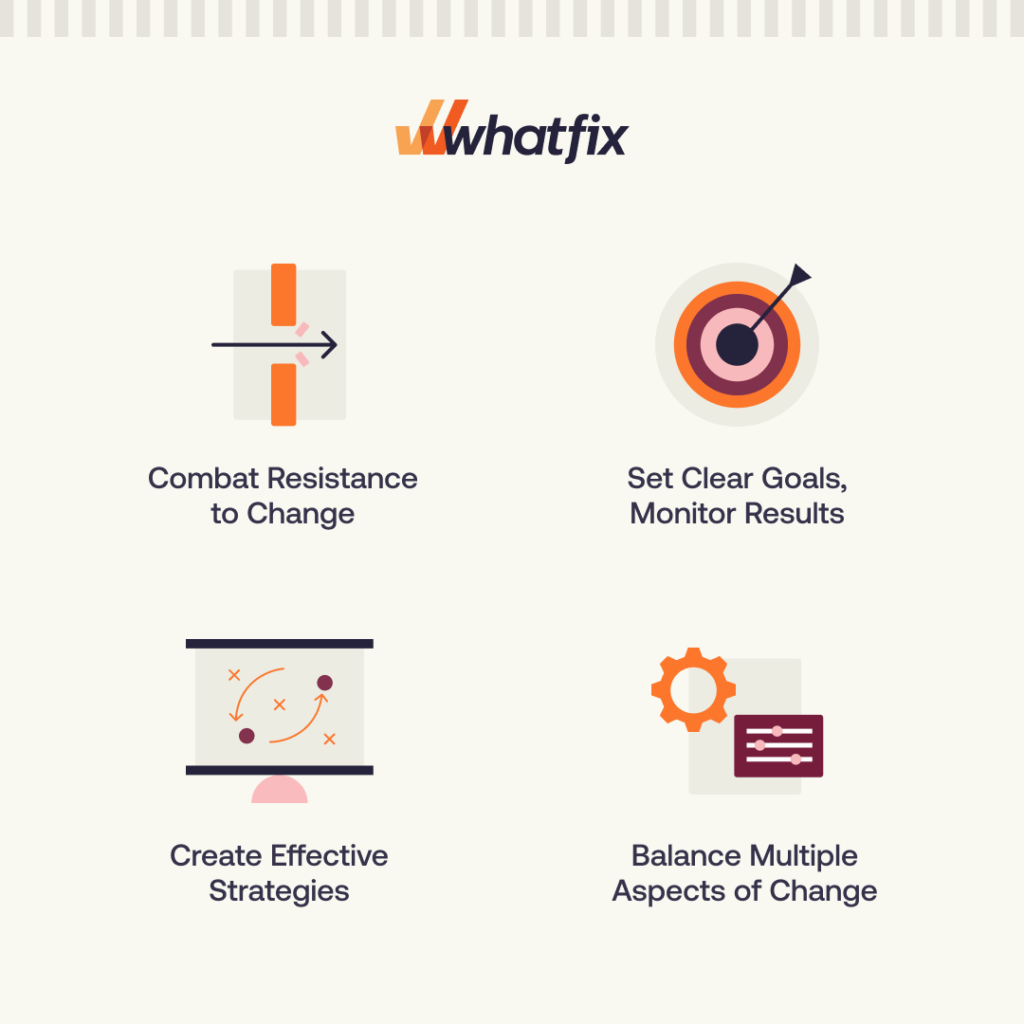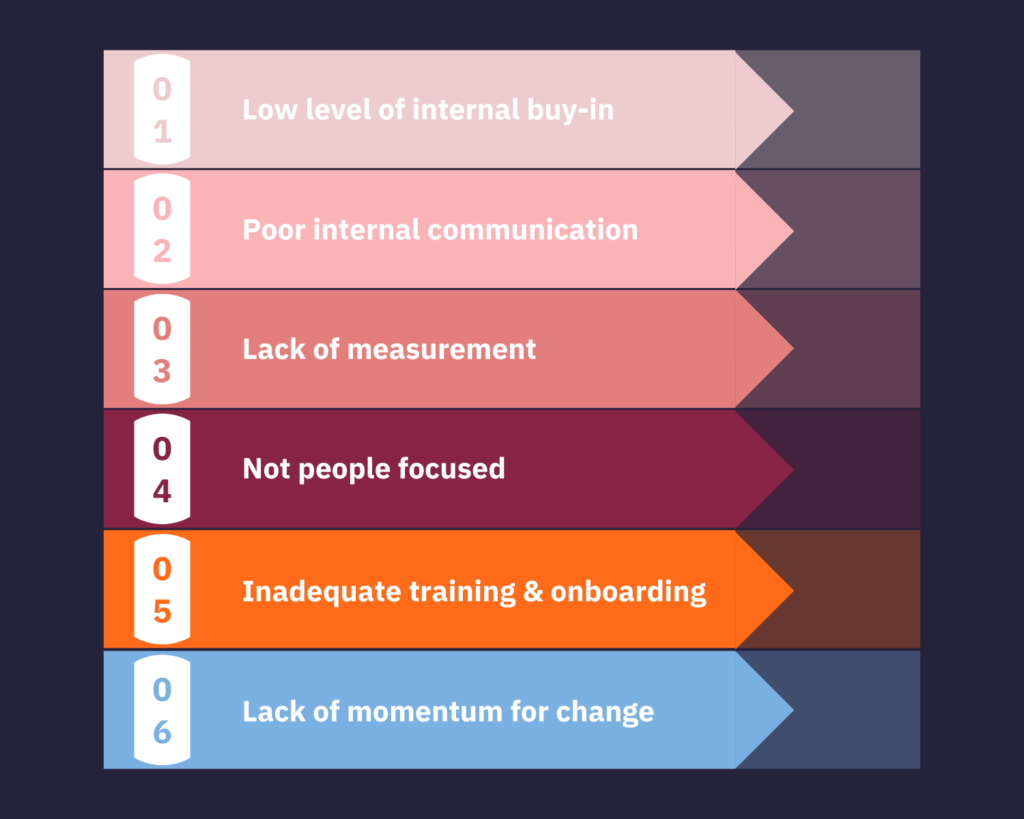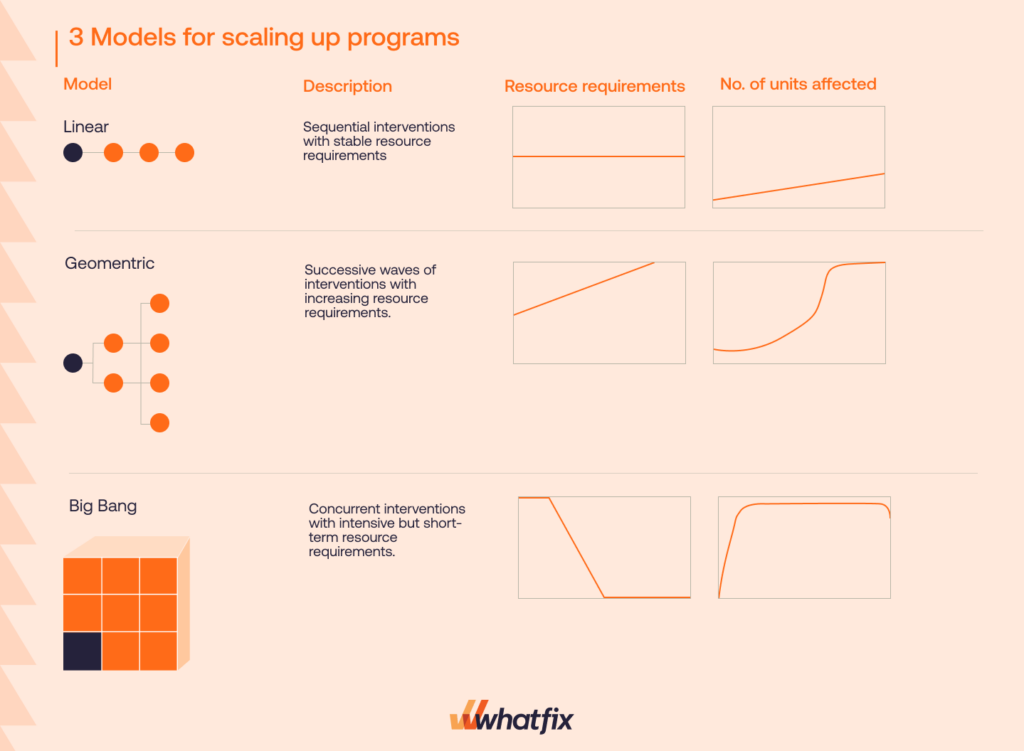What Is Change Management?
Change management is the process of guiding organizational change from start to finish, including planning, implementing, and solidifying changes in an organization. It refers to how companies handle modifications, such as the implementation of new technology, adjustments to existing processes, and shifting organizational hierarchy. This process can look different based on the type of change you are conducting.
Why Is Change Management Important?
Building a change management plan helps organizations make smoother transitions during times of change. You can mandate changes, but if you don’t have a plan for how to implement, monitor, and report on the success of that change, you’re setting yourself up to fail. Regardless of the type of change you want to make, change management gives you more control over the entire process – a process that is typically supporting a costly implementation plan and investment.
The different levels of change management include the following:
- Organizational or Transformational Change: This refers to large change management projects that are large in scale and scope. These change transformations are often dramatic, such as altering the organizational hierarchy, launching a new product, or undergoing digital transformation.
- Adaptive or Gradual Change: These change projects are smaller in scope and involve smaller changes to products, processes, strategies, and workflows. Adaptive change projects include implementing new software tools, hiring a new team member to solve an existing challenge, or updating a work-from-home policy.
- Individual Change Management: These change projects help individuals manage change to grow in their role and/or achieve specific goals. This could include learning a new skill.
Not all change initiatives will fit neatly into one of the levels of change management. In fact, it’s entirely possible for the levels to overlap.
For example, let’s say you are modifying your organizational chart and launching an upskilling training initiative for existing employees. If you also implement Workday to streamline your human capital management, your change would address all three levels.
Benefits of Change Management
All changes, big or small, benefit from well-thought-out change management. Change does not come naturally to people or organizations, so without proper management, you’ll likely hit barriers and waste time and money. Change management is the key to successfully implementing changes that stick.
The benefits of addressing change management at an organizational-level include:
- Proactively combatting internal resistance to change.
- Sets clear goals for change initiatives, allowing companies to monitor results.
- Creates strategies for implementing change effectively that can be standardized and applied to various change projects across the organization.
- Addresses and balances multiple aspects of change, such as people, processes, technology, etc.
- Empowers individuals and employees to navigate the change faster, allowing them to be more productive, faster.
- Enables the success of change projects, allowing organizations to find ROI on their transformation projects.

Types of Change Management
You can apply different types of change management best practices and theories, depending on the specific change you are navigating. Think about how you might approach each of these four types of changes:
- Exceptional change: Isolated events that change an individual’s experience but don’t majorly affect multiple aspects of their life. For example, a name change would require some HR paperwork and a new email address but wouldn’t alter the person’s role at work.
- Incremental change: Gradual changes that do not require major or sudden shifts, such as upgrading existing technology.
- Pendulum change: Sudden swings from one state to another, often switching from one extreme to the opposing view or state. For example, moving from a 100% in-office work environment to a 100% remote team.
- Paradigm change: Changes that result in new beliefs or values and become internalized as the new norm. For example, successfully shifting from synchronous communication to a hybrid model that involves both synchronous and asynchronous communication.

Top Reasons Why Change Management Initiatives Fail
To implement change successfully, determine why the change needs to happen in the first place. What are you trying to achieve, and why is that goal so important? How will the change benefit your organization, people, and processes?
Once you’ve settled on the overarching goal for your initiative, it’s helpful to understand what factors often trip up business leaders along their change management journey. Knowledge of the typical missteps can better inform your change management strategy.
Set your change initiative up for success by avoiding these common pitfalls.
1. Low level of internal buy-in
Without the support of leadership, the people most affected by the change, and internal change agents, your initiative is dead before it even begins. Establish change leaders early on to build internal support.
2. Poor communication
People need to understand why change has to happen and how it will affect them. Avoid vague announcements and mandates for change, and focus on clear, specific change communication.
3. Lack of measurement
Your change can’t be successful if you fail to define what success looks like. Set key performance indicators (KPIs) and metrics so you have a starting point, crucial milestones, and your desired end result.
4. Not people-focused
Many companies spend so much time planning the change itself that they neglect the people who will be affected by it. Even the most detailed change strategies can fail if they don’t focus on guiding people through the transition.
5. Inadequate training & onboarding
Whether you are adding new tools to your tech stack or adjusting internal processes, training is essential. Be sure to provide detailed, ongoing employee training during and after your software implementation process.
6. Lack of momentum
The ‘Enhanced Kotter’s 8-Step Change Model’ highlights the importance of sustained acceleration. Organizations often make the mistake of easing up on the change initiative too soon. It’s crucial to keep enthusiasm high all throughout the transition so you can continue to move toward your ultimate goals.

Learning from past mistakes provides historical references on what not to do. Look back at a few examples of change management failures now.
Best Practices to Manage Change Effectively
Organizational change requires dedicated planning, resources, attention to detail, and a focus on end-user enablement to empower those most impacted by change to appropriately adapt and adopt new processes, tools, and systems.
Based on our experience, here are ten critical change management best practices to ensure an effective transition and implementation.
1. Establish well-defined change governance structures
According to McKinsey research, change initiatives built on programs with strong governance and well-defined roles and responsibilities are 6.4x more likely to be successful.
This starts by creating a change committee, often called a change advisory board (CAB), with executive leadership buy-in, c-suite collaboration, change management officer(s), cross-functional executive sponsors, and department/team owners.
This team will be involved in creating processes to vet and prioritize change projects, the governance processes to take them from concept to reality, and what change management models and frameworks work best for your enterprise. They’ll also be responsible for tracking progress, monitoring adoption, facilitating communication, and providing guidance to the rest of the organization when exploring larger-scale change initiatives.
2. Talk with end-users most impacted by the change to understand their contextual challenge
Transformational change projects should improve core business processes and drive business outcomes. While leaders may understand these more extensive operational needs and can prioritize what change projects are most critical to business success, you can’t correctly understand the challenge or need without talking to those most impacted.
A vital part of any change project is to talk to the front-line workers who the change will most impact. Understand their current challenges and where they need the most support. This will help you understand the landscape of your change initiative, how the status quo negatively impacts your operations, and how a new solution or change can positively impact your business and these front-line workers.
Having transparent, open conversations with these employees will also allow you to secure buy-in from those asked to make significant changes in their day-to-day tasks. This establishes transparent communication with these critical employees and allows you to tackle internal resistance before it takes root.
3. Determine a change rollout method
How will you implement your change? That will depend on the size of the change, how many people it will impact, the risk involved, your IT resources, and more.
There are three significant models for rolling out and scaling your change programs, each with benefits, limitations, and resource requirements. Those include:
- The Linear Release Method slowly rolls out to users gradually and sequentially. This allows for a stable release of a change project without risking large-scale end-user rollouts. Support teams aren’t stretched too thin and can monitor smaller groups of users at the start of a rollout to monitor any issue.
- The Geometric Wave Approach allows you to take a phased implementation when taking a change live. You release the change to similar-sized groups of end-users at specific intervals. This gives your support teams the flexibility to be manageable while learning how to support end-users properly. This also promotes an agile-approach to change rollout, as organizations can make adjustments for each new cohort that the change is rolled out to.
- The Big Bang Release is pushing a change to all end-users simultaneously. This requires many support resources at the beginning of the release but fades over time. It’s the most risky of all releases, as you’re moving all your end-users to a new system, process, or technology all at once, meaning if an incident happens, it could knock out your entire operations and services.

4. Communicate early and transparently through a multi-channel approach to change announcements
The sender of your change announcement and updates should be contextual to the type of change you’re rolling out. More prominent organizational change announcements require more planning and a holistic strategy, while smaller, departmental-based change communication should come from the key stakeholders in those business units.
According to a survey from Prosci, 58% of employees prefer to receive communications about the personal impacts of change directly from their supervisors, followed by department heads (11%); CEOs, Senior Managers, and HR leaders, all failing to reach 10%.
When it comes to learning about organizational change, employees prefer the CEO to send change announcements and communication (37%), followed by executive leaders (24%), senior managers (10%), and department heads (10%).
Whoever is your change communicator, communicate to your employees (and anyone impacted by the change rollout) early and often. For internal change projects, take a multi-channel approach to announcing the change and when providing updates. Examples of channels to communicate change-related updates to employees include:
- Slack channels.
- Pop-ups and in-app announcements that overlay your employees’ digital workplace.
- Email.
- At all-hands and department meetings.
5. Leverage your change influencers
Change doesn’t happen by force—it requires influences across your organization to evangelize the project and drive acceptance and excitement. A change agent can (and should) play many roles, including communicating change-related news, showcasing wins, discussing issues with end-users, and more.
According to Malcolm Galdwell’s The Tipping Point, there are a few different types of internal influencers:
- Mavens: Build skills, transfer knowledge, and share advice.
- Connectors: Strong interpersonal communication skills and well-connected and liked throughout the organization.
- Salespeople: Can easily persuade others.
- Leaders: Senior leadership that employees look to follow who have earned trust.
6. Enable end-user employees with guidance and support in the flow of work
Organizations must navigate change and train employees on how to use new systems and processes without impacting employee productivity and output. This can be a significant roadblock for organizations unable to trade off output for process improvements.
By following the 70-20-10 rule of learning, IT and change teams can balance training employees on new software in the flow of work without disrupting day-to-day operations.
The 70-20-10 rule says that 70% of learning and skill acquisition comes from types of training with experiential learning and hands-on training. With Whatfix, organizations can create replica sandbox environments of their enterprise applications to provide live, interactive end-user training without risking live software usage.

With Whatfix DAP, employees are enabled to flow their work with in-app guidance and performance support like product tours, interactive walkthroughs, in-app tutorials, tooltips, task lists, and more.

7. Monitor progress, track end-user adoption, and be agile
Change advisory boards must plan change projects and own the rollout. They’re also tasked with monitoring the progress of change initiatives and tracking adoption and success metrics.
First, tie your change initiatives to more significant business metrics and outcomes. Then, create individual program-level metrics to monitor progress and success. Studies have found that setting and monitoring change KPIs leads to change initiatives succeeding at a 7.3x higher rate.
Change committees should monitor and track the following change-related metrics and progress indicators:
- Change milestones, budgets, and timelines.
- Operational performance metrics like wait and cycle times.
- Organizational health metrics, governance practices, and behavioral shifts can be tracked through end-user analytics, user surveys, one-on-one conversations, and team meetings.
- End-user adoption to ensure that new processes and applications are not only being used by employees (or customers) but that they’re being used correctly and efficiently, without friction.
- Key business outcomes intended by the change, including performance improvements (time-to-completion, improved revenue, reduced risk, deflect issues) and ensuring the change didn’t cause unintended consequences.
- New value created across the organization, like freeing up employee time to focus on more critical tasks, creating better customer experiences, etc.
Use these insights to take a data-driven, agile approach to your change initiatives. If things aren’t working as intended, take action and make changes. Change projects can quickly go off track, and change boards and leaders are there to keep projects aligned with goals and help remedy any issues.
8. Showcase early wins and productivity improvements in multiple channels
When monitoring change adoption, keep an eye out for early adopters. Track their productivity improvements and showcase how they’re accomplishing goals and driving business outcomes with the new software to help overcome internal resistance to change from other team members.
Showcasing how the change has positively impacted colleagues is an effective strategy for encouraging employees who show signs of being slow to adapt.
Use multiple channels to showcase early change wins, including all-hands meetings, Slack, and email threads.
9. Collect employee feedback before, during, and after the change project
Change feedback refers to collecting and analyzing end-user feedback related to change initiatives from those directly impacted by the change. Feedback loops enable organizations to improve the transition, migration, and application implementation processes, and ensure that changes achieve the desired business outcomes.
By collecting end-user feedback on change projects, organizations can:
- Identify issues early in change projects.
- Overcome resistance to change and address causes of change fatigue.
- Improve decision-making by including feedback from those most impacted by change.
- Build trust with end-users by clearly communication the “why” behind change projects.
With Whatfix, collect end-user feedback at critical moments in your change project, like during user testing, end-user training, and post-implementation.

10. Promote a culture that embraces change
Well-documented processes and handover procedures. Highly skilled employees with strong knowledge repositories that are easily accessible, contextual, and updated. Create feedback loops with employees to make change project charters to present to their department leaders or your change committee. Take a multi-channel end-user support approach to enable employees with IT-related resources that work to deflect issues and drive employee performance with contextual in-app help in the flow of work.
How to Build a Change Management Plan
A change management plan guides you and your team throughout the transition. These six change management plan steps (with change management templates to help you get started!)
- Create a change proposal: This is your argument for why the change needs to happen. Document the benefits, impact, and reason for the change.
- Identify change leaders: These are your vocal supporters of the change, usually senior-level management and other influential leaders. Be sure to mix a variety of roles on this change team.
- Create a change management communications plan: This is your plan for how you will communicate every aspect of the change to the people affected by it.
- Set goals and KPIs for the change: This is how you track the success (or failure) of various aspects of your change initiative. Create a plan to analyze the change after it goes into effect with goals and KPIs tied to business goals and outcomes. Make these visible to everyone in the organization to evangelize the project.
- Invest in change management tools: These are tools you need to support a new change project. These tools many include employee training software and change management software.
- Create a change management training plan: This is the outline for how training will be administered. You will need to collaborate with department leaders and the L&D team to create personalized change training plans that are contextual to each role.
Popular Change Management Models
Change management models are theories, concepts, and methodologies that serve as guides to successful change. While they do not provide step-by-step instructions, they do create a framework for managing the entire transition.
Before you choose a change management model, think about what you plan to modify. Certain models are better suited to specific types of changes. For example, people-centric changes often benefit from emotion-based change management models, such as the Kübler-Ross Change Curve or the Bridges’ Transition Model.
For changes that focus more on processes and systems, models such as the ADKAR Model or the Enhanced Kotter’s 8-Step Change Model can be very beneficial. Both models are outcome-oriented and provide a framework for accelerating transformations.
ADKAR’s Change Management Model
The ADKAR Model is built around five key outcomes, all around limiting the resistance to organizational change. They are:
- Awareness
- Desire
- Knowledge
- Ability
- Reinforcement

Kotter’s 8-Step Change Model
Kotter’s 8-Step Model guides you to do the following:
- Create a sense of urgency.
- Build a guiding coalition.
- Form a strategic vision and initiatives.
- Enlist a volunteer army.
- Enable action by removing barriers.
- Generate short-term wins.
- Sustain acceleration.
- Institute change.
Change Management Software
Change management tools include software and apps that support the change process. They can provide in-app training, create knowledge bases, track progress, and more.
Whatfix empowers organizations to drive change adoption by creating contextual application experiences and streamlined workflows for end-users. With Whatfix, you can achieve business outcomes by enabling end-users with contextual guidance and support in the flow of work, end-user analytics, simulated hands-on training, in-app user communication, and real-time feedback collection.
With Whatfix DAP, use a no-code editor to create in-app guided experiences like Tours, Flows, Task Lists, Smart Tips, and more to provide end-users learning and support in the flow of work.

With Self Help, connect your knowledge repositories to an AI-powered in-app resource center that provides contextual support to your users at the moment of need, right in your employees’ applications and workflows. Whatfix’s AI-powered digital adoption platform also provides insights into how users engage with and consume your in-app content with Guidance Analytics and collects feedback through in-app Surveys.

With Whatfix Mirror, you can easily create simulated IT environments for your CRM, ERP, HCM, or any mission-critical software to provide hands-on user training without impacting your real application or its data.
With Whatfix Product Analytics, track any custom user end-user event to identify friction in your internal processes. Create Funnels and Journeys to understand how your employees or customer end-users are navigating through workflows and tasks. Create Cohorts to identify change adoption trends across teams, departments, or user groups.
Use this data to make process improvements, streamline tasks, and create frictionless workflows that enable end-users.
Ready to get started? Request a Whatfix demo today!
Change
Management
FAQs
What Is organizational change management (OCM)?
Organizational change management refers to the ways companies handle changes to the people, processes, tools, and systems in their organization. To manage change, organizations need a plan for implementing changes and solidifying those changes as the new norm.
There are four types of organizational change to know:
- Strategic transformational change: Large-scale changes that require significant adjustments, such as updating your company’s mission statement or employee benefits package
- People-centric change: Adjustments that have a considerable effect on people, such as redefining roles and responsibilities, modifying leave policies, or hiring new employees
- Structural change: Major changes to organizational hierarchy, usually caused by mergers and acquisitions
- Remedial change: Reactionary corrections to unexpected problems that need to be solved immediately, such as hiring a replacement for an employee who put in their notice or addressing customer complaints
What are common steps of the change management process?
The change management process is how you get from Point A (the existing state) to Point B (your desired change). Those steps include:
- Determine the reason for the change.
- Set specific goals for the change.
- Establish key performance indicators (KPIs) and milestones to monitor progress.
- Refer to change management models.
- Create a change management plan and implementation strategy.
- Designate change leaders.
- Implement change.
- Gather feedback.
- Analyze progress and results.
What are examples of change management projects?
Change management can be applied to various industries and functions — anytime you make a significant change to how things work within an organization, you’ll need to manage that change.
Here are a few change management examples across industries and functions.
- Enterprises: A large company moving to hybrid work/
- SaaS Companies: The introduction and launch of a new product.
- Healthcare: Hospitals switching to a new electronic medical records system.
- Sales Teams: Sales organizations change how they log deals and opportunities in their CRM.
- Grocery Stores – Adopting a new curbside pickup service.
How do I improve my change management process?
No change initiative is perfect, but you can always learn from the experience. To continuously improve upon your change management process, you have to track and analyze each step. During and after your initiative, think about the following questions, and let them guide you toward a more effective process in the future.
- Determine the reason for the change: Did you make a convincing argument for the change?
- Set specific goals for the change: Did you achieve those goals?
- Establish key performance indicators and milestones to monitor progress: Did you hit milestones and achieve your desired KPIs according to your established timeline?
- Refer to change management models: Did the change management model guide you through your specific change initiative?
- Create a change management plan and implementation strategy: Was your strategy detailed enough to serve as a helpful guide throughout the transition?
- Designate change leaders: Were your change leaders vocally supportive of the change and able to persuade others to be supportive?
- Implement change: Did the implementation process go as planned and stick to your established timeline?
- Gather feedback: How did the people affect by the change feel about how the process was handled?
- Analyze progress and results: Which parts of the process went well, and which aspects need improvement?
Request a demo to see how Whatfix empowers organizations to scale enterprise-wide changes, improve user productivity, and drive user adoption fast.